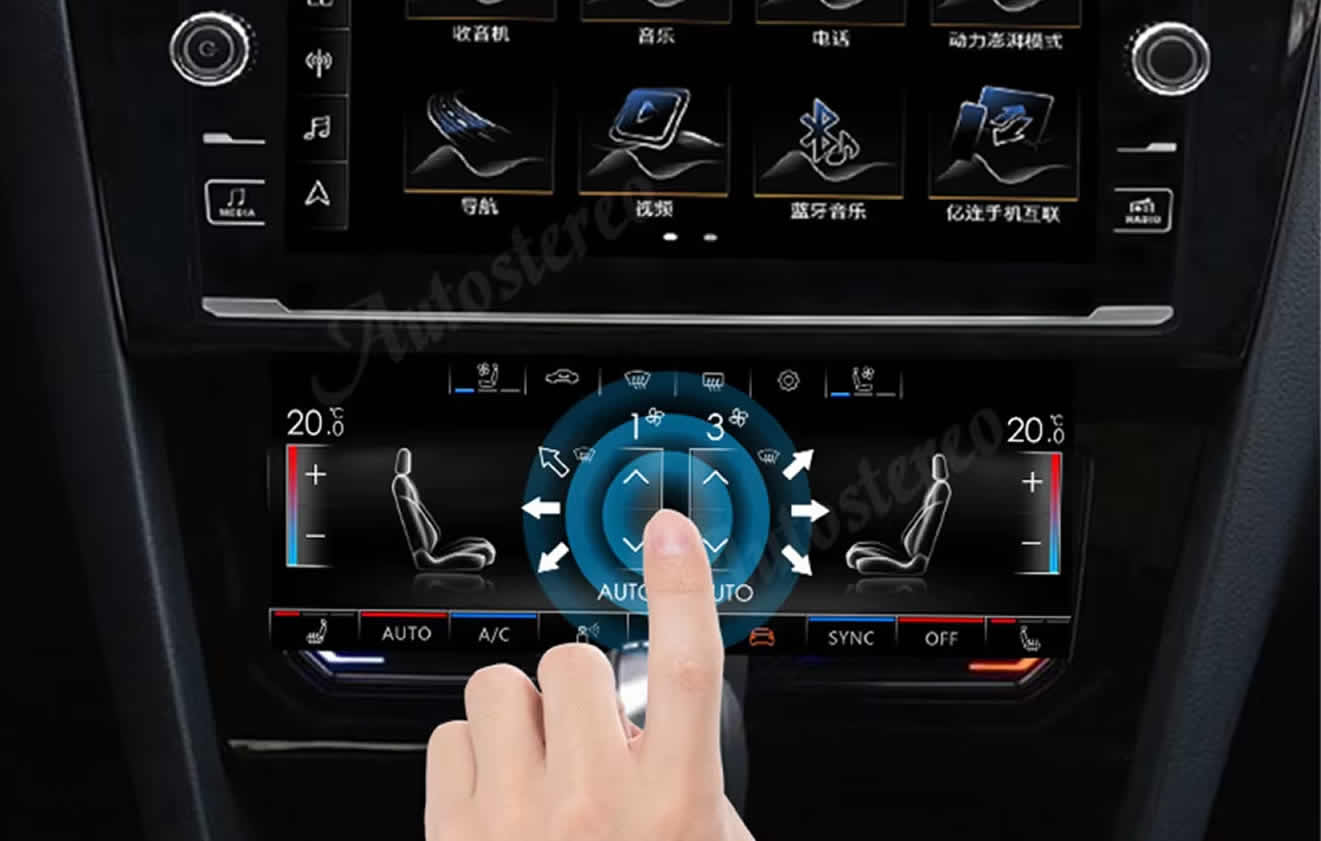The Volkswagen Golf 7 established itself as one of the most versatile and respected hatchbacks of the last decade, admired for its solid engineering, efficiency, and technology. When Volkswagen introduced the Golf 7.5 facelift in 2017, it wasn’t just a minor refresh. The Golf 7.5 brought meaningful changes in design, interior quality, digital systems, and performance, while also introducing innovations such as the Digital Touch Climate Control For Golf 7/7.5. This article provides a comprehensive comparison, highlighting where the Golf 7.5 improved over the Golf 7, and why the facelift version became a popular choice among buyers.
From the outside, the differences between the Golf 7 and Golf 7.5 are subtle but noticeable. The original Volkswagen Golf 7 had a clean, timeless design, but the facelift sharpened the overall look. Slimmer LED headlights replaced the older xenon options, with integrated dynamic turn signals adding a premium touch. The front bumper received a wider grille and sportier air intakes, while the taillights switched to full LED clusters with distinctive light signatures. Wheel designs were updated across trims, and new metallic paint options were added. The Golf 7.5 may look similar at a glance, but when parked next to a Golf 7, the facelifted model appears fresher and more upscale.
Inside, the evolution was even more significant. The Volkswagen Golf 7 came with physical buttons and knobs for most functions, including climate settings. While functional, it lacked the digital sophistication that buyers were beginning to expect. Enter the Golf 7.5 with its reimagined center console and the new Digital Climate Control for Golf 7 series, also called the Touch Climate Control for Golf 7. Instead of conventional knobs, Volkswagen implemented a touch-sensitive panel that allowed drivers to adjust cabin settings with swipes and taps. The system integrated seamlessly with the updated infotainment screen and created a cleaner, more modern appearance. These new Golf 7 Climate Control Settings stood out as a leap forward in usability and precision.
The facelift went further with climate features. The Golf 7.5 Climate Control Features included improved multi-zone control, humidity sensors, faster windscreen defrost, and smarter airflow adjustment. Volkswagen optimized cabin insulation and ventilation, meaning that the system cooled or heated the cabin quicker than in the older Golf 7. This is reflected in numerous Golf 7 Digital AC Reviews, where owners consistently praised the accuracy and speed of the new system. Drivers also found the VW Golf AC Panel Settings intuitive once they got used to touch commands, although a few still preferred the tactile feel of buttons from the previous version.
Beyond interior comfort, the Golf 7.5 introduced major digital upgrades. While the Volkswagen Golf 7 had reliable infotainment systems, the facelift brought larger touchscreens, sharper graphics, and gesture control on the 9.2-inch Discover Pro system. More importantly, higher trims featured the fully digital Active Info Display instrument cluster, replacing analog gauges with a customizable 12.3-inch screen. This change reinforced Volkswagen’s focus on creating a digital-forward environment, complementing innovations like the climate system.
Engine choices were another area of improvement. The Volkswagen Golf 7 offered a solid lineup of petrol and diesel options, but the Golf 7.5 introduced new engines with more efficiency and power. A standout was the 1.5 TSI Evo petrol engine with Active Cylinder Management, producing 130 to 150 horsepower while seamlessly shutting down two cylinders under light loads to save fuel. The facelift also brought updates to the GTI, which now made up to 245 horsepower, and the Golf R, which reached as high as 310 horsepower with all-wheel drive. Diesel models also saw refinements, with the 2.0 TDI offering up to 184 horsepower. While the Golf 7 was already efficient, the Golf 7.5 pushed boundaries with improved emissions, better fuel economy, and a smoother overall drive.
Driving dynamics between the two models also showed incremental refinements. Both cars shared the same MQB platform, but the Golf 7.5 benefitted from retuned suspension, improved steering response, and optimized gearbox calibration for DSG models. On the road, the facelift felt slightly sharper and more composed without sacrificing comfort. The upgrades to the Golf 7.5 Climate Control Features also meant that cabin comfort was better maintained during spirited drives or long journeys.
Safety technology advanced significantly with the facelift. While the Volkswagen Golf 7 had good equipment for its time, the Golf 7.5 added features such as Traffic Jam Assist, Pedestrian Monitoring, and improved Adaptive Cruise Control with stop-and-go capability. Lane Assist, Blind Spot Detection, and Front Assist with emergency braking became more widely available across trims. The Golf 7.5 earned a 5-star Euro NCAP rating, reflecting Volkswagen’s ongoing commitment to occupant safety.
User reviews highlight how the Golf 7.5 improved day-to-day usability. In forums and Golf 7 Digital AC Reviews, owners frequently mentioned the convenience of the new climate panel. The VW Golf AC Panel Settings allowed them to fine-tune airflow and temperature more quickly than before. Families especially appreciated the independent multi-zone settings. The ability of the Digital Touch Climate Control For Golf 7/7.5 to quickly defog windows or maintain stable cabin comfort added to its practical value.
When comparing value, the Golf 7.5 positioned itself as a more future-proof car than its predecessor. The added digital technology, refined engines, and safety upgrades made it more competitive against rivals like the Ford Focus, Honda Civic, and Audi A3. While the Volkswagen Golf 7 remains a strong used-car choice for buyers on a budget, the Golf 7.5 is the smarter pick for those who want updated digital systems like the Digital Climate Control for Golf 7, advanced driver aids, and an overall more premium driving experience.
In conclusion, the Golf 7.5 wasn’t just a facelift—it represented a significant step forward in technology, comfort, and efficiency. The changes in design sharpened its looks, while the interior overhaul with the Touch Climate Control for Golf 7 and upgraded infotainment transformed the cabin experience. Enhanced engines and safety features further solidified its appeal. For buyers comparing the Volkswagen Golf 7 and Golf 7.5, the facelift version stands out as the more complete package. Thanks to innovations such as the Golf 7.5 Climate Control Features and the praised VW Golf AC Panel Settings, it became one of the most desirable hatchbacks of its time and a symbol of Volkswagen’s ability to evolve while staying true to its iconic Golf identity.









